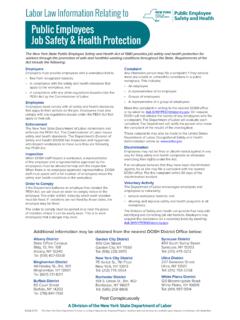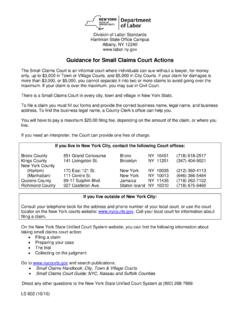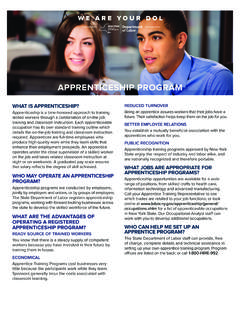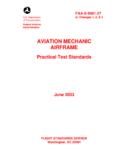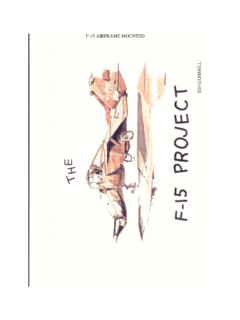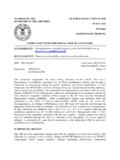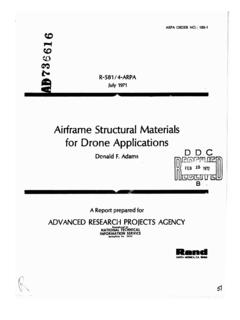Transcription of AIRFRAME & POWERPLANT MECHANIC APPENDIX A
1 ATP 53-563H (06/2018) Apprentice Training Section Page 1 AIRFRAME & POWERPLANT MECHANIC (Hybrid) APPENDIX A CODE O*NET CODE WORK PROCESSES Hybrid apprenticeships are premised on attainment of demonstrated, observable and measurable competencies in addition to meeting time-based work experience and on-the-job learning requirements. This training outline is a minimum standard for Work Processes and Related Instruction. Changes in technology and regulations may result in the need for additional on-the-job or classroom training. Approximate Hours Minimum/Maximum A. Workplace Orientation 30/50 1. Demonstrate knowledge of workplace policies, procedures, etc. 2. Work safely around equipment. 3. Follow workplace safety plans; use appropriate Personal Protective Equipment (PPE).
2 B. AIRFRAME Basics 40/60 1. Differentiate between types of aircraft, , fixed-wing, rotary wing, gliders. 2. Identify major structural stresses experienced by all aircraft. ATP 53-563H (06/2018) Apprentice Training Section Page 2 3. Identify major components of fixed-wing AIRFRAME : a. fuselage; b. wings; c. tail section; d. flight control surfaces; e. landing gear. C. AIRFRAME /Aircraft Maintenance Fundamentals 1000/1200 1. Reading aircraft maintenance manuals, both manufacturer- specific and Federal Aviation Administration (FAA)-approved circulars. 2. Learn and utilize Location Numbering Systems (LNS) for various aircraft, including zones and subzones for large aircraft. 3. Become familiar with aircraft rigging, including: Type Certificate Data Sheets (TCDS), maintenance manuals, cable systems, structural alignment, checking and safetying the system.
3 4. Perform all manner of aircraft inspection such as: AIRFRAME Conformity, Airworthiness, Altimeter and Static System, Annual and Continuous Airworthiness Maintenance Program (CAMP). 5. Perform sheet metal and non-metallic structures repair work. all manner of sheet metal tools, including but not limited to: dividers, rivet spacers, punches, kettsaws, shears, snips, forming tools, vises, rivet guns to make repairs. aircraft finishes. D. AIRFRAME Systems & Instruments 1000/1200 1. Inspect, maintain, and troubleshoot electrical system components, such as: wiring, pins, connectors, AC and DC systems throughout AIRFRAME . 2. Inspect, maintain, and repair common aircraft electrical systems, , lighting, engine starting, and power distribution.
4 3. Inspect, troubleshoot, and check flight, engine, and navigation instruments, such as: pressure gauges, airspeed indicators, vertical speed indicators (aka rate-of-climb indicators), tachometers, compasses (internal maintenance and line replaceable units work performed by others). 4. Inspect, troubleshoot, and check various other avionic systems, such as: radio, passenger address interphones, radar beacon transponders, global positioning systems (GPS). 5. Inspect, troubleshoot, and repair hydraulic and pneumatic ATP 53-563H (06/2018) Apprentice Training Section Page 3 power systems. 6. Identify, inspect, troubleshoot, and repair landing gear systems, including: shock absorbing equipment, brakes, retraction mechanisms, wheels, and tires.
5 7. Inspect, check, service, and troubleshoot aircraft fuel systems. 8. Inspect, check, and troubleshoot aircraft ice and rain control systems. 9. Inspect, check, troubleshoot cabin atmosphere control systems. 10. Inspect, check, and troubleshoot fire protection systems, including fire detection and extinguishing systems. E. Aircraft POWERPLANT 1000/1200 1. Become familiar with turbofan engine type. 2. Identify other engine types, such as reciprocating, radial, inline, gas turbine (if applicable). 3. Use hand tools to perform work, including but not limited to: wrenches, screwdrivers, socket sets, cordless drills, torque wrenches. 4. Troubleshoot, inspect, and repair fuel system components, such as: main fuel pumps, fuel heaters, fuel filters, and fuel spray nozzles.
6 5. Check, inspect, and repair engine induction and exhaust system components. 6. Inspect, troubleshoot, and repair thrust reverser systems. 7. Inspect, maintain, and repair POWERPLANT electrical systems by employing proper wiring techniques, , lacing, bundling, clamping, and splicing. 8. Check, service, and repair lubricating and cooling systems. 9. Identify, inspect, and maintain engine instruments/systems. 10. Inspect, maintain, and service turbine-powered Auxiliary Power Units (APUs). 11. Maintain, inspect, service engine fire protection systems. 12. Utilize all manner of rigging to perform POWERPLANT work, , repositioning turbofan engines. ATP 53-563H (06/2018) Apprentice Training Section Page 4 F. Miscellaneous Skills (Optional*) 40/60 1.
7 Indentify, inspect, and repair wooden AIRFRAME components. 2. Select and apply fabric and/or fiberglass AIRFRAME coverings. 3. Perform welding associated with the trade. _____ Total Approximate Hours (Minimum/Maximum) 3110/3770 *If optional work processes are not selected, the hours should be devoted to further mastery of the other required work processes. Apprentices in this Hybrid Apprenticeship Program shall participate in no fewer than 3110 documented hours of on-the-job training, and until they have demonstrated a competency for each skill in the Work Processes, with the understanding competency will be demonstrated reasonably proximate to the maximum on-the-job training hours. Competency Assessment described in further detail in APPENDIX B. Apprenticeship work processes are applicable only to training curricula for apprentices in approved programs.
8 Apprenticeship work processes have no impact on classification determinations under Article 8 or 9 of the Labor Law. For guidance regarding classification for purposes of Article 8 or 9 of the Labor Law, please refer to New York State Education Department Page 5 AIRFRAME & POWERPLANT MECHANIC (Hybrid) APPENDIX B RELATED INSTRUCTION Safety & Health General Workplace Safety First Aid & CPR (minimum hours every 3 years) Personal Protective Equipment (PPE) Right-to-Know/Safety Data Sheets (SDS) Lock-Out/Tag-Out (LO/TO) Sexual Harassment Prevention Training (minimum 3 hours) General Skills and Theory Basic Mathematics and trade-specific math Aircraft Drawings Basic Electrical Concepts Trade Science and Theory Aviation Concepts Aircraft/ AIRFRAME Terminology Aerodynamics Avionics Trade Skills Tools Rigging Hydraulic Systems Landing Gear Systems Environmental Control Systems Anti-ice/De-ice Systems Fire Protection Systems Structural Identification Electrical Circuits Structural Repair Aircraft/ AIRFRAME Construction Rivet Layout/Joints/Installation/Repair Aircraft Fuel Systems New York State Education Department Page 6 Aircraft Engines Engine Component Replacement Pressurization Flight Control Systems Engine Electrical/Electronic Controls Instruments FAA Manuals/Manufacturer Manuals Recordkeeping Title 14 Code of Federal Regulations (14 CFR)
9 FAA Advisories/Circulars Competency Assessment Test Prep Passing FAA Aviation Maintenance Technician General AIRFRAME and POWERPLANT Knowledge Test (adminstered by FAA) - written and practical exam A minimum of 144 hours of Related Instruction are required for each apprentice for each year. Other required courses as necessary.
